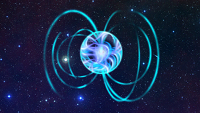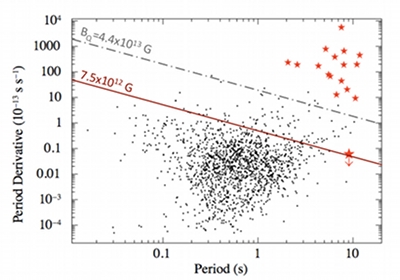Are most pulsars really magnetars in disguise?
14 October 2010
Astronomers using XMM-Newton and other world-class X-ray telescopes have probed a curious source, which emits flares and bursts just like a magnetar but lacks the extremely high external magnetic field typical of these objects. The detection of this source, which could be powered by a strong, internal magnetic field hidden to observations, may mean that many 'ordinary' pulsars are dormant magnetars waiting to erupt.Massive stars remain objects of curiosity even well after their demise. Ending their lives in dramatic fashion, as supernova explosions, they leave a very dense and compact remnant behind - a neutron star or a black hole, depending on the mass of the star. These remnants, characterised by intense gravitational fields, are the source of some extremely energetic events and give rise to a variety of interesting phenomena which can be observed throughout the entire electromagnetic spectrum.
 |
|
Artist's impression of a magnetar. Credit:ESA |
Neutron stars, in particular, derive from the collapse of stars originally as massive as 8 to 25 times the mass of the Sun and they harbour magnetic fields a million times stronger than the strongest ones ever produced on Earth. Spinning neutron stars can be observed as pulsating sources -hence the name, pulsars- with exceptionally short periods, ranging from about one thousandth of a second to ten seconds. Powerful beams of electromagnetic radiation are created by jets of energetic particles that stream out above the magnetic poles of the star; the 'blinking' effect arises because the pulsar's magnetic dipole is not always aligned with its axis of rotation. Young pulsars rotate extremely fast but release rotational energy and slow down as they age: older pulsars have thus longer periods than younger ones. By measuring the rate at which a pulsar spins down it is possible to estimate the intensity of its surface dipolar magnetic field.
Magnetars are a special class of pulsars that stand out from the crowd because of their striking characteristics: they have long rotations periods, occasionally undergo episodes of extremely enhanced emission (about 10–100 times the usual value) and produce intense, short bursts of X-rays and gamma-rays.
"Ordinary pulsars are powered by their rotation. The extreme events observed in magnetars, instead, require an additional energy reservoir, believed to reside in a particularly strong magnetic field," says Nanda Rea from the CSIC - Institute of Space Sciences in Barcelona, Spain, who led the study which is to be published in the journal, Science. "Thus far, 15 magnetars were identified, all of them exhibiting extraordinarily high values of the surface dipolar magnetic field," she adds.
All of these magnetars have magnetic fields of about 1014–1015 Gauss, hundreds to thousands of times stronger than those detected in ordinary pulsars. The object of the study of Rea and collaborators, a source called SGR 0418+5729, appears to challenge this trend. "Surprisingly, SGR 0418+5729 behaves just like a magnetar, with a period of about 9 seconds and evidence of intense X-ray bursts, but its magnetic field is not remotely as strong as a magnetar's. In fact, it is of the same order as that of an ordinary pulsar's magnetic field," explains Rea.
Astronomers monitored SGR 0418+5729 for several months employing virtually all available X-ray telescopes, including XMM-Newton, Chandra, RXTE and Swift, in order to achieve the most complete coverage possible.
"The use of XMM-Newton was particularly beneficial in this context," comments Norbert Schartel, XMM-Newton Project Scientist. "Its large effective area allows observations to be performed at high sensitivity, which translates into a very precise estimate of the period of the source."
After months of observations with a series of world-class telescopes, no sign of variation in the period of SGR 0418+5729 was recorded. This allowed astronomers to place only an upper limit on its dipolar magnetic field, which must be smaller than 7.5 x 1012 Gauss. With such a weak magnetic field, what can be powering the intense bursts and the overall magnetar-like behaviour of this puzzling source?
|
The spin-period/spin-down rate diagram for pulsars. The location of SGR 0418+5729 expands the region of the period/period-derivative space in which magnetars may be found. Credit: Image courtesy of N. Rea. |
"Astronomical measurements are only sensitive to the dipolar magnetic field of a pulsar," explains co-author Sandro Mereghetti from INAF-IASF in Milan, Italy. "However, SGR 0418+5729 could conceal a strong magnetic field in its interior, which would cause the bursts and extreme emission but remain unnoticed by any observations,” he adds.
If this scenario proves to be true, it would dramatically change the standard picture astronomers have regarding magnetars, lifting the curtain on a large population of pulsars with a broad range of magnetic field values. "This would mean that many sources, currently classified as 'ordinary' pulsars, could turn on as magnetars at any time, regardless of the surface dipolar magnetic field we measure," comments Rea.
In order to assess that, more observations of SGR 0418+5729 have to be performed. Depending on whether its spin-down rate is close to the current limit or is much lower than it, anything from a few months up to a few years of careful monitoring will be needed before a firm estimate of the surface magnetic field can be obtained. If this turns out to be significantly lower than the current limit, then the entire magnetar scenario might need to be revised.
"The new framework affects also our theoretical understanding of supernova explosions that lead to the formation of neutron stars," says Mereghetti. In order to produce a remnant with such a strong inner magnetic field, explosions must be more powerful than those currently accounted for. Such scenarios could also lead to intense emission of gravitational waves.
"We are eager to perform further observations of this baffling object and to determine whether it actually represents the norm or the exception," Rea concludes.
Related publications
Rea, N., et al., "A low-magnetic field Soft Gamma Repeater", Science Express, published online 14 October 2010. DOI: 10.1126/science.1196088
Notes for editors
SGR 0418+5729 was discovered on 5 June 2009 by the Fermi Gamma-ray Burst Monitor (GBM), which recorded two magnetar-like bursts of hard X-rays. Follow-up observations were conducted for 160 days with several X-ray satellites in order to monitor the source and measure its period. These observations are necessary to estimate the rate at which the object possibly spins down and, from this, to derive the value of the dipolar magnetic field.
For the first 160 days of observations, SGR 0418+5729 showed no sign of variations in the rotation period. After that, SGR 0418+5729 could not be monitored for a while because its position on the sky was too close to the Sun's.
An extensive monitoring of SGR 0418+5729, involving XMM-Newton, Swift, and Chandra, began on 9 July 2010. The current estimate of the period, based on a best fit to all data, is P=9.07838827 seconds.
To date, no variation of the period has been detected; the upper limit is of P_dot<6.0 x 10-15, which translates into a surface dipolar magnetic field B< 7.5 x 1012 Gauss.
Contacts
Nanda Rea
Institut de Ciéncies de l'Espai (CSIC-IEEC)
Barcelona, Spain
Phone: +34-935814366
E-Mail: rea ieec.uab.es
ieec.uab.es
Sandro Mereghetti
INAF–IASF, Milano, Italy
Phone: +39-02-23699323
E-Mail: sandro iasf-milano.inaf.it
iasf-milano.inaf.it
Norbert Schartel
ESA XMM-Newton Project Scientist
Directorate of Science and Robotic Exploration, ESA, The Netherlands
Phone: +34-91-8131-184
Email: Norbert.Schartel esa.int
esa.int



